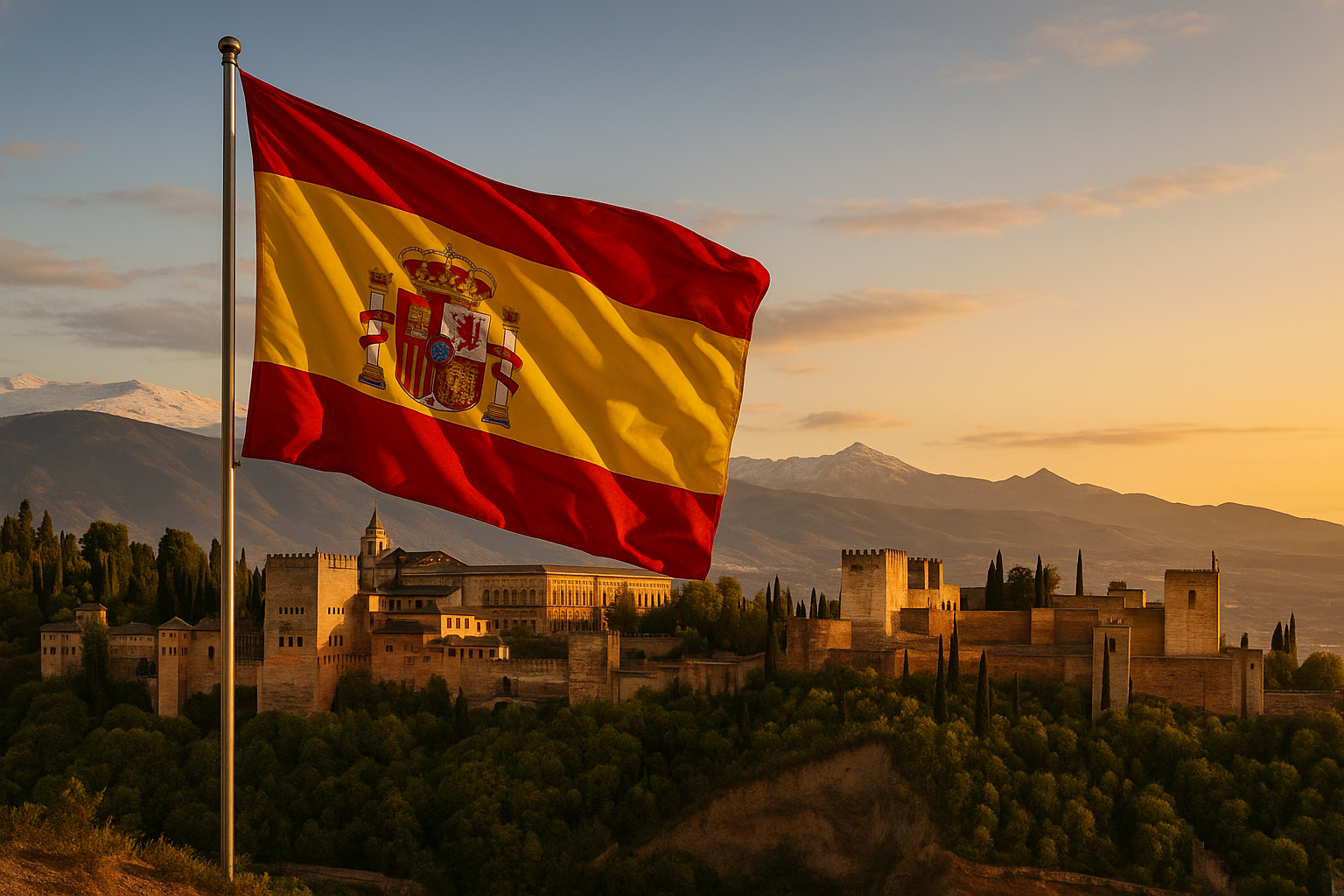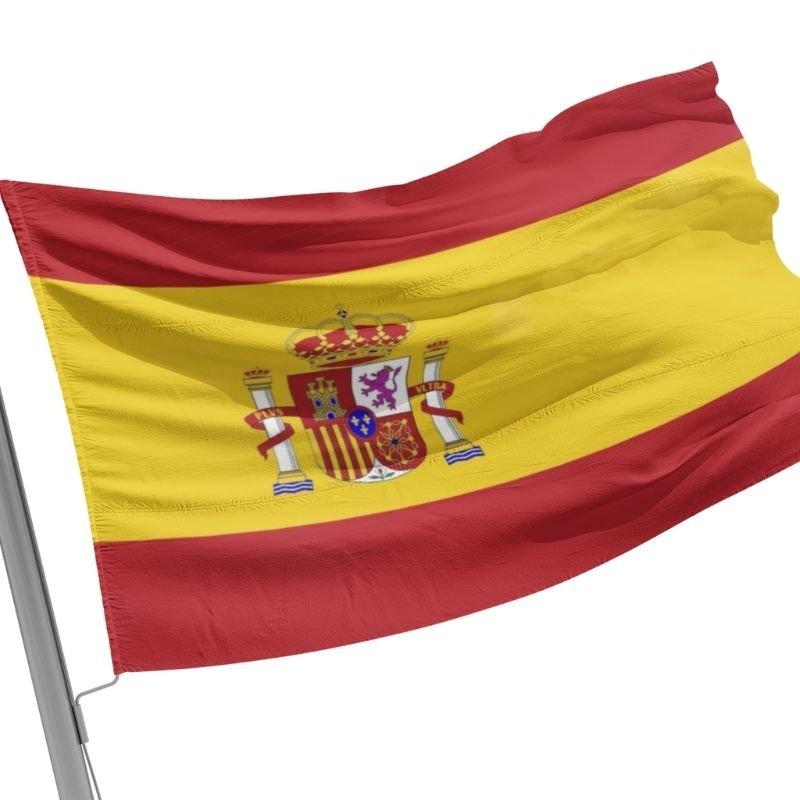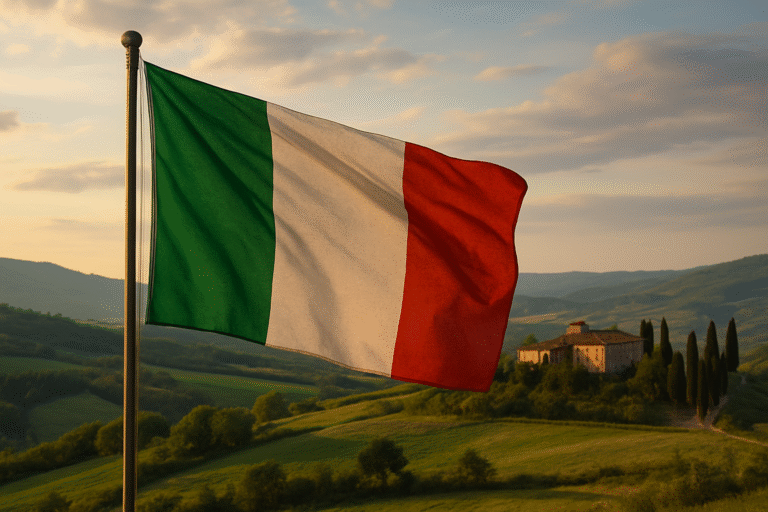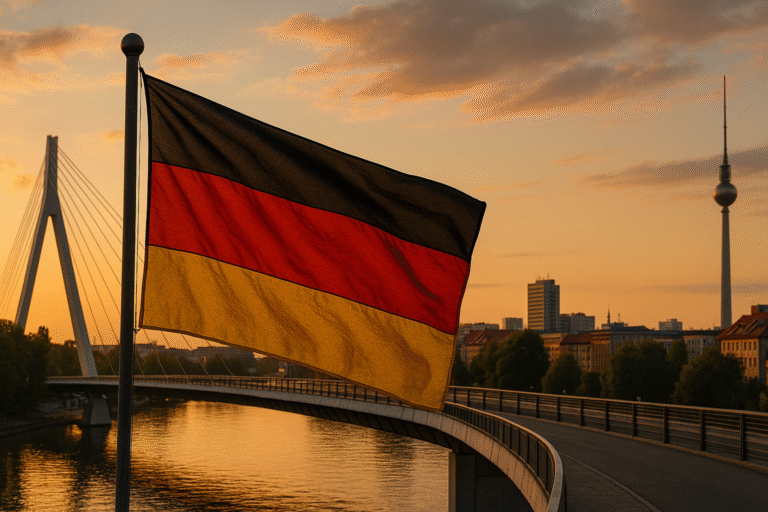
Spain Flag: Colors, Meaning, History, Origin
The Spanish flag, with its vibrant horizontal bands of red and yellow, stands as one of Europe’s most recognizable national emblems. This distinctive flag, known in Spanish as “la Rojigualda,” represents centuries of complex history, national unity, and cultural heritage. Its evolution mirrors Spain’s own transformation from a collection of kingdoms to a unified modern nation, capturing the essence of Spanish identity through carefully selected colors and symbols.
Quick Summary
The Spanish flag’s distinctive red yellow red design originated in 1785 when King Charles III needed to distinguish Spanish naval vessels from similar looking ships of other nations. What began as a practical maritime solution gradually evolved into Spain’s national symbol.
Before 1785, Spain used various royal standards including the Burgundy Cross. The new flag’s colors connect to historical kingdoms that formed Spain. Red representing Castile and yellow symbolizing Aragon. Though initially only used at sea, by 1820 it was officially adopted for broader national use.
Throughout Spain’s tumultuous history, the flag transformed with each political shift. The First Spanish Republic (1873 1874) added stripes, the Second Republic (1931 1939) introduced purple, Franco’s regime (1939 1975) featured the Imperial Eagle, and the democratic transition created today’s design with a coat of arms representing Spain’s historical kingdoms.
This coat of arms contains elements symbolizing Castile (castle), León (lion), Aragon (vertical stripes), Navarre (chains), and Granada (pomegranate). The Pillars of Hercules with “Plus Ultra” motto reference Spain’s historical expansion beyond Europe.
Today, the flag exists in several official variants including the civil flag (without coat of arms), state flag (with coat of arms), war flag, and naval ensign. Each with precisely specified colors and proportions regulated by law.
The Origin of the Spanish Flag
The birth of the modern Spanish flag can be precisely traced to the reign of King Charles III in the late 18th century. Before 1785, Spain lacked a unified national banner, instead utilizing various royal standards and maritime ensigns across its vast territories and naval fleets.
The creation of the flag stemmed from practical necessity rather than nationalistic sentiment. King Charles III faced a significant problem with Spanish naval operations. Spanish warships, bearing white ensigns with the royal coat of arms, were frequently confused with similar flags of other European powers, particularly the French Bourbon naval ensigns. This confusion occasionally led to unfortunate friendly fire incidents during naval engagements.
In 1785, to address this issue, King Charles III ordered Antonio Valdés, his Minister of the Navy, to propose distinctive flag designs that would be clearly visible at sea and unmistakably Spanish. The minister presented the king with twelve different designs, from which Charles III personally selected the red-yellow-red horizontal pattern we recognize today.
The chosen design featured two horizontal red bands at the top and bottom with a wider yellow band in the center. The yellow stripe is twice the width of each red stripe, creating a balanced and distinctive appearance. This design was officially established by Royal Decree on May 28, 1785, though initially only as a maritime ensign for the Spanish Navy.
The selection of red and yellow colors was not arbitrary. These hues had deep historical connections to the Spanish monarchy and territories. The red represented the ancient kingdom of Castile, while yellow symbolized the kingdom of Aragon. Together, these two realms formed the core of what would become unified Spain following the marriage of Ferdinand II of Aragon and Isabella I of Castile in the 15th century.
What began as a practical maritime solution gradually evolved into a powerful national symbol. The flag was first exclusively used by the naval forces, with the Spanish Army continuing to use its traditional white banners. However, its distinctive appearance and practical visibility gradually led to wider adoption across Spanish institutions and territories.
By 1820, during Spain’s constitutional period, this flag was officially adopted by royal decree for use beyond naval purposes, marking its transition from a purely maritime ensign to a true national flag. This established the red-yellow-red pattern as the permanent foundation for all future Spanish flags, though the specific emblems and coats of arms displayed within would change with different regimes throughout Spanish history.
The origins of the Spanish flag thus reflect a blend of practical necessity and historical symbolism, a design chosen for visibility at sea that would eventually come to represent an entire nation and its diverse heritage.
Historical Evolution
The Spanish flag’s journey from a maritime ensign to a universal national symbol spans more than two centuries of political transformation, reflecting Spain’s complex historical narrative through its various iterations.
Pre-1785 Flags and Royal Standards
Before Charles III established the red and yellow design, Spain utilized a diverse array of banners and standards. The Burgundy Cross (Cruz de Borgoña), a diagonal red saltire on a white field, served as a prominent symbol of Spanish military forces since the 16th century under Habsburg rule. Various royal houses displayed their own heraldic emblems, while different kingdoms within the Spanish realm maintained distinct regional standards. Naval vessels often flew white flags featuring the royal coat of arms, creating the identification problems that eventually led to the flag reform.
From Maritime Symbol to National Emblem
Following its introduction in 1785, the red-yellow-red design gradually expanded beyond naval use. In 1793, coastal fortifications were permitted to display the new flag, extending its presence on Spanish shores. The transition accelerated during the turbulent Napoleonic period, when Spanish resistance against French occupation galvanized national identity. By 1820, during the Liberal Triennium, the flag was officially designated for broader national use, appearing on government buildings and in civilian contexts for the first time.
The First Spanish Republic (1873-1874)
The brief First Spanish Republic introduced significant modifications to the flag. Republican governments adopted a tricolor design by adding a third red band at the bottom, creating a red-yellow-red-yellow-red pattern. This distinctive five-striped version symbolized the break with monarchical tradition. The royal coat of arms was replaced with new republican emblems featuring regional symbols. However, this republican flag’s lifespan was short, lasting only until the Bourbon restoration in December 1874.
The Restoration Period (1874-1931)
The return of the Bourbon monarchy under Alfonso XII restored the traditional red-yellow-red design. During this period, the flag featured the royal coat of arms prominently displayed in the center of the yellow band. This era saw the standardization of the flag’s proportions and the refinement of the coat of arms design. The Spanish flag became more visible internationally as colonial conflicts brought Spain into global spotlight, particularly during the Spanish-American War of 1898.
The Second Spanish Republic (1931-1939)
The establishment of the Second Spanish Republic in 1931 brought another significant transformation. The republican government adopted a tricolor flag with horizontal stripes of red, yellow, and purple (replacing the bottom red stripe). This distinctive republican flag represented progressive ideals and a break with monarchical symbolism, with purple specifically honoring the historical communities of Castile. The coat of arms was again modified to feature republican symbols including the castle, lion, and other regional emblems arranged within a circular design.
The Franco Era (1939-1975)
Following the Spanish Civil War, Francisco Franco’s nationalist regime restored the traditional red-yellow-red pattern but introduced a distinctive coat of arms featuring the Imperial Eagle (Águila de San Juan) behind the shield. This design, associated with Catholic Monarchs Ferdinand and Isabella, incorporated various elements including the Pillars of Hercules with the motto “Plus Ultra,” the yoke and arrows of the Falangist movement, and other traditional Spanish emblems. This version of the flag became strongly associated with Franco’s authoritarian regime and its national-catholic ideology.
Democratic Transition and Modern Era (1975-Present)
With Spain’s transition to democracy following Franco’s death in 1975, the flag underwent its final major evolution. The current design was officially adopted in 1981, maintaining the traditional red-yellow-red pattern while replacing Franco’s eagle with the current coat of arms. This modern emblem includes representations of Castile, León, Aragon, Navarre, and Granada, crowned by the Spanish royal crown. The pillars of Hercules remain, but fascist symbols were removed, creating a design that honors Spain’s historical kingdoms while embracing democratic values.
Throughout these transformations, the basic red-yellow-red pattern established by Charles III has endured as the foundation of Spanish national identity, despite the political upheavals and regime changes that characterized Spain’s modern history. Each modification to the flag has reflected the political ideology and national vision of its era, making the Spanish flag not merely a national symbol but a visual chronicle of Spain’s historical evolution.
Symbolism and Design
The Spanish flag’s distinctive appearance carries deep symbolic meaning, with each element carefully chosen to represent aspects of Spain’s historical legacy and national identity.
Color Symbolism
The red and yellow colors that define the Spanish flag hold significant historical associations, though their official interpretation remains deliberately open. The vibrant red traditionally connects to qualities of valor, strength, and the blood spilled defending the nation through centuries of conflict. The golden yellow represents generosity, justice, and Spain’s historical wealth during its imperial era.
Several theories explain the origin of these colors in Spanish heraldry. The most widely accepted connects them to the historical kingdoms that formed modern Spain. Yellow derives from the gold background of Castile’s coat of arms, while red comes from the field of León’s emblem. Another theory links the colors to the Crown of Aragon, whose heraldic symbol featured four red bars on a golden shield.
Interestingly, Charles III chose these colors primarily for their practical visibility at sea rather than their symbolic associations. The combination of red and yellow creates high contrast visible from great distances in maritime conditions, fulfilling the original practical purpose of distinguishing Spanish vessels from other nations’ ships.
The Coat of Arms
The current Spanish coat of arms, positioned on the yellow band, serves as a complex heraldic summary of Spanish history. Adopted in 1981 and modified slightly in 2014, it contains elements representing the different historical kingdoms that united to form Spain:
- The castle (top left quarter) represents the Kingdom of Castile
- The lion rampant (top right quarter) symbolizes the Kingdom of León
- The vertical red and gold bars (bottom left) represent the Crown of Aragon
- The chains (bottom right) stand for the Kingdom of Navarre
- The pomegranate at the bottom center represents the Kingdom of Granada
Surrounding these quarters, the coat of arms features the Pillars of Hercules draped with a banner bearing the motto “Plus Ultra” (Further Beyond), referencing Spain’s historical expansion into the Americas and beyond the traditional boundaries of the classical world. The royal crown tops the shield, symbolizing Spain’s constitutional monarchy.
Flag Proportions and Specifications
The Spanish flag follows precise specifications established by law. The flag’s proportions are 2:3, meaning its width is two-thirds of its length. The yellow stripe occupies half the flag’s width, while each red stripe takes up one-quarter. The coat of arms is positioned slightly toward the hoist side of the center in the yellow band.
Official regulations dictate exact color specifications using the Pantone matching system: the red corresponds to Pantone 186C and the yellow to Pantone 116C. These specifications ensure consistency across all official representations of the flag.
Flag Variants
Spain utilizes several official variants of the national flag:
- The civil flag (without the coat of arms) serves as the general version used by civilians and for most non-governmental purposes
- The state flag (with the coat of arms) represents official government institutions and the Spanish state
- The war flag features a different, elongated version of the coat of arms and is used exclusively by the military
- The naval ensign adds a lighter blue tone to the coat of arms, distinguishing naval vessels
The civil flag without the coat of arms remains legally recognized as an official version rather than an incomplete flag, a unique arrangement among European nations that typically consider their emblems integral to their flags.
Regional Interpretations
While the official symbolism remains consistent, different regions within Spain sometimes attach varied meanings to the national colors. In Catalonia, some historically associate the red and yellow with the regional flag’s own colors, claiming the national flag derives from Catalan heraldry. This interpretation reflects the complex relationship between national identity and regional autonomy within Spain’s diverse territories.
The careful balance of historical elements in the Spanish flag creates a symbol that acknowledges Spain’s monarchical traditions while embracing its modern democratic identity. The design communicates both continuity with Spain’s past and its evolution into a contemporary European nation, making it a living document of Spanish history rendered in cloth.





